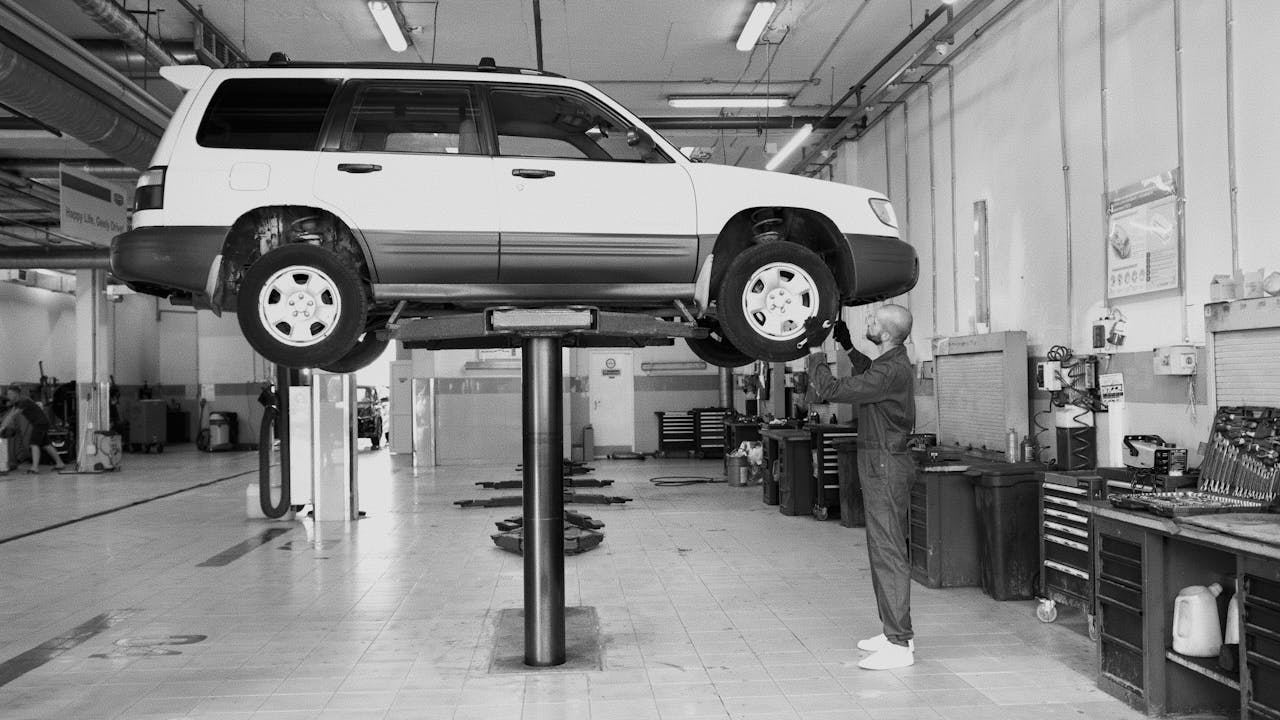A brake pad replacement guide covers the types of brake pads, how long they last, and what it costs to change them. Brake pads come in common types like ceramic, metallic, and organic, each with its pros for daily drives or heavy use. Most brake pads last around 50,000 km, although your everyday habits, the roads you take, and your vehicle all play a role in determining whether they’ll wear out sooner or endure longer. Replacing brake pads costs the type of car brand and location where the work is done, but most of us can expect to pay between basic to high-end service. To assist with savvy decisions on car maintenance, the upcoming sections explain each component in depth.
Key Takeaways
- There are four common types of brake pads—organic, ceramic, semi-metallic, and performance—each carrying their unique advantages and compromises based on your vehicle, driving style, and conditions.
- It is best to have your brake pads inspected regularly for signs of wear, unusual noises, and changes in braking performance to be on the safe side and ensure optimal stopping power.
- Brake pad lifespan depends on a variety of factors, including driving style, road conditions, climate, and your vehicle, so it’s essential to tailor your maintenance approach to your individual situation.
- Replacement costs vary widely based on pad type, labor rates, and potential hidden expenses, so compare pricing and consult a professional to budget accurately.
- OEM VS. AFTERMARKET BRAKE PADS When deciding between OEM and aftermarket brake pads, you’ll want to carefully weigh options in terms of compatibility, performance, and warranty to get the best result for your vehicle.
- Driving habits, regular maintenance, and new brake technology can help you squeeze the most service and performance out of your brake pads.
Understand Brake Pad Types
Brake pads are an integral part of a vehicle’s braking system, with a direct impact on safety, performance, and maintenance expenses. The primary types are organic, ceramic, semi-metallic, and performance pads. Each type fulfills different requirements, based on driving habits, terrain, and the bike design. Picking the right brake pad begins with understanding their material makeup, strength,s, and weaknesses, and how they suit particular driving requirements.
|
Type |
Advantages |
Disadvantages |
|
Organic |
Quieter, lower cost, less rotor wear |
More dust, shorter lifespan |
|
Ceramic |
Quiet, low dust, long life |
Higher cost, less effective in cold |
|
Semi-Metallic |
Durable, great heat dissipation |
Noisier, more dust, pricier |
|
Performance |
High temp resistance, top stopping power |
Faster wear, costly, and noisy |
Organic
Organic brake pads use fibers from rubber, glass, and sometimes Kevlar. These pads are selected for quiet stops and soft pedal feel. They don’t generate a lot of heat whilst braking, so they’re designed for everyday lives and urban usage.
Cost-conscious drivers frequently choose organics, thanks to their lower price compared to other pads. They’re a trade-off, however, as these pads wear quicker and deposit more brake dust on wheels. Their lifespan varies with commute style and traffic, but for light driving, they’re a smart choice.
Ceramic
Ceramic pads are best for smooth, quiet stops and clean wheels. They infuse dense ceramic compounds with fine copper fibers, so they wear much longer than organics. Their primary appeal is their low dust output, which helps keep wheels clean.
While they carry a higher initial price tag, ceramic pads provide long-term value. They manage a variety of temperatures and road conditions without fading. For mixed climate drivers or those seeking less maintenance, ceramics are a solid choice.
Ceramic pads work quietly, even under hard braking, which appeals to comfort-seekers.
Semi-Metallic
Composed of metal shavings combined with other fillers, semi-metallic pads are hard and heat-machine hungry. Their construction makes them perfect for larger cars or aggressive driving, where heat buildup can be an issue.
These pads excel in heavy use, given their fast heat shedding and smooth braking. They’re not magic—anticipate additional noise, dust, and a higher cost than organic pads.
Performance
Performance pads are designed for quickness and stopping under pressure. They employ cutting-edge compounds to combat heat and deliver consistent braking in rugged conditions.
These pads wear down quicker because they’re softer, so anticipate more frequent swaps. They can require professional installation and frequent monitoring to maintain performance.
When To Replace Brake Pads
Brake pads are a safety-critical component for any vehicle, and knowing when to replace them ensures consistent, reliable braking. Pad life depends on driving habits and the environment — urban or stop-and-go traffic tends to wear them more quickly than highway use. As a general guideline, replace pads when the friction material is under seven millimeters. Frequent inspections, recognizing crucial warning signs, and monitoring performance can help you avoid brake failure and costly repairs.
Signs It’s Time to Replace Your Brake Pads:
- Loud noises (squealing, grinding) when braking
- Pad thickness less than 7 mm
- Soft or vibrating brake pedal
- Increased stopping distance
- Pads worn unevenly, cracked, or damaged
- The manufacturer’s mileage guidelines reached
1. Audible Warnings
Squealing or grinding when you brake is usually the first indicator that the pads are wearing out. These noises come from tiny metal tabs embedded in many pads, designed to alert you when the material gets too thin. Ignoring these sounds can lead to damage to the rotors or calipers, significantly increasing repair costs. Even a faint squeak or scraping noise deserves attention. Responding quickly can prevent further damage and keep your vehicle safe.
2. Visual Inspection
You can often inspect the brake pads yourself by looking through your wheel spokes. If you see thinning friction material, cracks, chips, or uneven wear, it’s time for a replacement. The pad thickness should not be less than 7 mm. Make it a habit to check your brake pads during routine maintenance, such as oil changes, to stay ahead of potential issues.
3. Pedal Feel
A spongy brake pedal or one that sinks lower than normal may indicate that the brake pads are worn. In some cases, the pedal may pulse or vibrate, especially if the pads are wearing unevenly or if the rotors are damaged. If the pedal doesn’t feel right, don’t ignore it—have your brakes inspected immediately to avoid further problems.
4. Performance Loss
If your vehicle takes longer to stop or the braking feels less responsive, your brake pads may no longer be doing their job. This isn’t just inconvenient—it’s dangerous. Reduced braking power, especially in wet conditions, can put you and others at risk. If you notice any decline in performance, schedule an inspection without delay.
Factors Influencing Pad Life
Brake pad life is not set in stone; it depends on a variety of factors. Knowing these specifics allows you to schedule replacements and maintain healthy brakes. Life span is typically from 40,000km to 105,000 km, but will vary depending on your habits, environment, and vehicle. Key factors include:
- Driving habits and style
- Brake pad type and material (organic, semi-metallic, ceramic)
- Vehicle weight and design
- Road and weather conditions
- Regular maintenance and inspections
- Brake pad quality and fit
- Frequency of stop-and-go traffic
- Towing or carrying heavy loads
- Terrain: city, rural, hilly, or flat
Your Driving Habits
Your driving style dictates your pad life. Hard braking and rapid driving grind down pads far quicker than even moderate driving.
If you brake late and hard, you overload your pads. This assists pads in longevity. Driving in dense, stop-and-go traffic, like city streets or rush hour, wears it out faster. Light highway use is gentler on pads.
Carrying heavy loads or overloading your car adds more stress to the brakes. This reduces pad life. Attempt to maintain your car’s weight near its rated capacity.
Your Environment
City driving with lots of stops is hard on brake pads. You stomp on it more, which means more abrasion.
Hilly or steep terrain requires more braking, particularly downhill. This increases brake temperature and accelerates wear. Warm weather and regions with heavy rain or snowfall can affect braking performance and pad wear. Wet roads might help cool the brakes, but they can add more grit and drag.
If you suffer from extreme conditions, check your brakes more frequently. You might have to swap out pads earlier than in temperate arid regions.
Your Vehicle
Different cars require different brake pads. Tiny cars employ lighter pads, and large trucks or SUVs require tougher, thicker ones.
Your car’s weight and construction are important. Heavier cars eat pads faster. All-wheel-drive and four-wheel-drive systems tax brakes as well. Always check what your maker recommends for your car.
If you don’t, ask a brake expert. They’ll assist you in selecting pads that suit your vehicle and driving habits.
Maintenance Factors
Regular checks can prevent minor issues from spiraling into major ones.
Wash your brakes frequently, particularly if you commute in dirt or snow.
Adhere to the manufacturer’s inspection intervals, typically every 24,000 to 32,000 km.
Change your pads before they get too thin.
The Cost Of Replacement
The cost of brake pad replacement extends beyond the parts sticker. Labor, supplemental parts, and the vehicle influence what you ultimately pay. Knowing each cost keeps surprises at bay and lets you choose what fits your needs and budget.
Parts
Brake pad costs vary by material and manufacturer. Organic pads often run $30 a set, whereas semi-metallic pads can be anywhere from $40 to $100. Ceramic pads regularly cost a little more, as high as $120 per set; however, they endure and endure quietly. Rotors are $30 to $75 a piece, and if you need calipers, one can be as much as $130. For luxury or foreign cars, parts can be higher, sometimes twice as much.
Less expensive pads cost less immediately, but wear quicker and may not brake as effectively. Quality pads wear longer — up to 70,000 miles — and provide superior stopping ability. It pays to shop around at local and online stores for bargains, as prices can vary dramatically for the same part.
Labor
Labor is a lot of the cost. It’s anywhere from $90 – $200 an hour. How long the job will take varies depending on your vehicle. Certain cars require additional steps, such as the removal of other components, which increases the price. Always get quotes from multiple shops. Some mechanics have a flat rate, and others charge hourly. The expertise and prestige of the repairman count. A nice shop is more expensive, but you get peace of mind and fewer screw ups.
Hidden Costs
Brake jobs have a way of uncovering additional work. Rotors can require resurfacing, too, which adds expense, sometimes $20 to $40 per rotor. Sometimes the fluid needs changing, or a caliper leaks. These extras can drive a no-frills job into the $300 to $800 range, or more, on some vehicles. Request a complete quote, with potential add-ons, before work commences. Schedule inspections and pad replacements to prevent minor problems from escalating into major, expensive repairs.
|
Component |
Cost Range (USD) |
|
Brake Pads (per axle) |
$30–$120 |
|
Rotors (each) |
$30–$75 |
|
Caliper (each) |
Up to $130 |
|
Labor (per hour) |
$90–$200 |
|
Full Repair (per axle) |
$300–$800+ |

OEM VS. Aftermarket Pads
When selecting brake pads, the decision is typically OEM vs. Aftermarket. OEM pads are developed by the company that built your car, or by a partner working to the car maker’s specifications. They fit perfectly and utilize materials selected to perform optimally with your car’s brake system. A lot of drivers swear by OEM pads because the feel and stopping power are consistent with what was there originally. Most OEM pads will go around 30,000 miles or so, some pushing well past that if you drive easily. The price is higher, but the warranty—typically a year—provides comfort. You know what you’re getting, and you know it works.
Aftermarket pads are from a variety of brands, not connected to your vehicle manufacturer. This broad landscape translates to greater choices for your cash and your commute. Some aftermarket pads employ stronger materials, such as ceramics or semi-metallic compounds. Ceramics are silent and have a long life. Semi-metallic pads manage heat effectively and provide solid stopping power, but can wear down rotors more quickly. Organic pads, constructed of rubber, Kevlar, or fibers, are soft, quiet, and gentle on rotors; however, they don’t last as long. With aftermarket, 20k to 70k miles, or more. A few brands have limited lifetime warranties as well, which will save you some money long-term if you hold onto your receipts and abide by their policies.
Quality varies more with aftermarket pads, however. Some are designed for heavy-duty applications, such as racing or towing, and others target daily driving. Prices vary from less than OEM to a lot higher, depending on material and design. Aftermarket pads might alter pedal feel or braking noise, so check reviews if you care about those things. Always check the brand’s warranty and return policy prior to purchase. While certain brands support their pads with robust warranties, others do not.
Maximizing Brake Pad Longevity
Brake pad longevity is a combination of your driving technique, how you maintain your car, a nd the quality of brake pads you install. To keep pads going strong, begin with simple inspections. Grounds for Inspection — Regular brake inspections — say, every 10,000 miles — will help detect thin pads, uneven wear, or contamination early. If the friction material is below 6 mm, it’s time to change it. When you catch these signs early, you prevent damage to other brake components, such as rotors, which can be much more expensive to repair.
One of the best ways to maintain brake pads is to stay on top of regular cleaning and maintenance. WASH OFF DUST AND DEBRIS FROM CALIPERS AND PADS. Dirt can cause screeching and sluggish braking, and wear things out more quickly. Check brake fluid too, since aged or contaminated fluid can damage the entire system. For the majority of cars, alter the liquid every 32,000 to 72,000 km. This easy trick helps extend brake pad life.
Driving habits are a killer. If you ride the brakes, stop hard, or drive fast in stop-and-go city traffic, pads wear out a lot faster. Use your brakes as little as possible – slow down easily and maintain a nice gap between other cars. This causes you to use your brakes less and for them to last longer. For hills, mountains, or harsh riding conditions, pads will wear quickly. These cases require additional inspections and rapid replacement. Take city vs. Highway drivers: the former might require fresh pads after 32,000 km, while the latter can push to 80,000 km.
Installation counts as well. Pads that are not installed properly can result in uneven wear and premature demise. Just ensure that whoever installs your pads is professional and takes the correct precautions. This saves you headaches later on down the line.
Stay on top of new brake pad varieties and technology. Other pads are designed to last longer or perform better in specific weather conditions. Watch for updates from your car maker or trusted sources. Selecting the correct pad for your requirements assists you in achieving the ideal balance of security, price, and longevity.
Conclusion
Brake pads are a huge component for safe driving. Pads are available in several varieties—ceramic, metallic, and organic. All feel and wear different things. Many drivers replace pads every 25,000 to 50,000 miles, but stop-and-go traffic, aggressive braking, or heavy hauling can reduce that span. OEM pads are more expensive, but fit perfectly and then some. Aftermarket pads provide more choices of cost and type. Regular inspections, friction-free braking, and debris-free wheels extend pad life. Catch squeaks or brake-feel changes early to avoid large bills down the road. For a safe car and a happy wallet, monitor pad wear and consult a pro if you notice something strange. Have other brake questions? Leave them in the comments or contact me.
Frequently Asked Questions
1. What Are The Main Types Of Brake Pads?
There are four main types: ceramic, semi-metallic, organic, and low-metallic. Each provides various advantages in longevity, noise, and braking performance. Go with one or the other depending on the needs of your particular driving style and vehicle.
2. How Often Should Brake Pads Be Replaced?
Brake pads will often need replacement every 30,000 to 70,000 kilometers. Consult your vehicle’s owner manual. Squeaking, less braking, or dashboard alerts mean it’s time to check them.
3. What Factors Affect Brake Pad Lifespan?
Driving style, road quality, vehicle, and pad material all affect longevity. Hard braking, heavy loads, and city driving will wear pads out faster.
4. How Much Does Brake Pad Replacement Cost?
Prices depend on your car and type of pads, but figure $100 to $300 an axle — labor included. Aftermarket pads can even be cheaper than OEM counterparts.
5. What Is The Difference Between OEM And Aftermarket Brake Pads?
OEM pads are produced by the car’s manufacturer. Aftermarket pads are produced by other manufacturers. OEM pads provide assured fit and quality. Aftermarket pads might be cheaper and have greater selections.
6. How Can I Make My Brake Pads Last Longer?
So drive gently, don’t make sudden stops, and minimize carrying heavy loads. Regularly check your braking system. Good habits and maintenance can prolong brake pad life.
7. Are Ceramic Brake Pads Better Than Other Types?
Ceramic pads are quieter and dust-free. They’re more durable, but at a higher price. They may not do as well in extreme cold or for heavy-duty trucks. Select according to your driving requirements.
Need Brake Repairs You Can Truly Rely On?
When it comes to your safety, don’t settle for average. At autoTECH Blackhawk, we specialize in high-performance, precision brake repair backed by experience and trust. What sets us apart? We’re not just about fixing cars — we’re about building real relationships with our clients and keeping your vehicle running safely for the long haul.
From squeaky brakes and soft pedals to full rotor and pad replacements, our expert team handles it all with care and precision. You’ll get peace of mind with our industry-leading 3-year/36,000-mile warranty, plus the confidence of knowing we only use top-quality, manufacturer-recommended parts.
Your brakes keep you safe — let’s make sure they’re ready for anything.
Call our friendly team today to book your contactless brake repair consultation. Let’s get you back on the road, worry-free.


